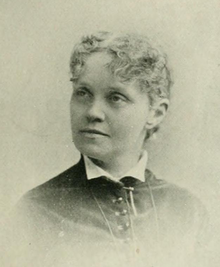This documentation needs attention from an expert in Indigenous peoples of North America. The specific problem is: Need Seneca verification on adoption and leadership claims. (December 2016) |
Harriet Maxwell Converse | |
|---|---|
 | |
| Born | Harriet Arnot Maxwell January 11, 1836 Elmira, New York |
| Died | November 18, 1903 (aged 67) |
| Nationality | American |
| Genre | Folklore, poetry |
| Notable works | Sheaves |
Harriet Maxwell Converse (née, Harriet Arnot Maxwell; Seneca clan name, Gayaneshaoh;[citation needed] Seneca tribal name, "Ya-ie-wa-noh, meaning ‘she watches over us.’")[1] (11 January 1836 - 18 November 1903) was an American author of Scottish and Irish heritage. She was a folklorist, poet and historian of the Iroquois; by the late 19th century, they were a loose confederacy of six nations in New York State and Canada. She became an advocate for the rights of the Seneca and other Iroquois tribes in New York state, helping them retain their lands and preserve their culture. In recognition of her contributions, the Seneca made her a member of the tribe and gave her an honorary position as a Sachem or chief of the Six Nations.[2]
With an appropriation in 1897 from the New York State Museum, Converse made extensive purchases of Iroquois artifacts from private collectors and tribes to have them preserved by the state. She also donated a family collection that was a century old. She persuaded the Onondaga to transfer their collection of historic wampum belts of the Five Nations to the state museum for preservation.[2]
- ^ Regents, New York State MuseumUniversity of the State of New York Board of, Annual report of the Regents - New York State Museum., retrieved 2021-03-15
- ^ a b James, Edward T.; James, Janet Wilson; Boyer, Paul S. (1971). Notable American Women, 1607–1950: A Biographical Dictionary. Harvard University Press. pp. 375–376. ISBN 978-0-674-62734-5.